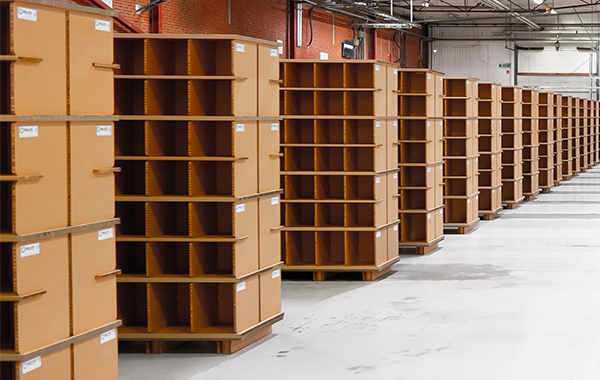Early warehouse shelving storage systems tended to be relatively simple and fixed, consisting of stationary shelves made from wood or metal. Items were manually placed on and retrieved from shelves and, while this method was an improvement on storing items on floors, there was a lack of flexibility, and little use of vertical space.
With the rapid rise in e-commerce warehouse managers realised they needed to improve the efficiency, organisation, and space optimisation of their warehouses. There’s been quite a few advancements in shelving systems for warehouses over recent years with the introduction of new, more sophisticated and increasingly versatile shelving solutions.
PALLITE® shelving systems for warehouses
PALLITE® warehouse storage solutions combine the very best features of modern shelving systems for warehouses with sustainability at their core. Not only are they modular, flexible and durable, but designed to help suppliers play their part in a greener, circular economy.
Here’s a quick overview of how warehouse shelving systems have evolved to meet the demands of modern, dynamic supply chains starting with traditional metal shelving.
The limitations of traditional metal shelving
Traditional metal shelving, while still widely used and fairly reliable, has limitations that can impact the productivity of modern warehouse operations. Key limitations include:
- Limited storage density: Traditional metal systems generally consist of fixed shelves at fixed heights and depths. This rigid design can lead to inefficient use of vertical space, especially if storing items of different sizes. This wasted overhead space has less storage density compared to more advanced shelving systems like pallet racks, or automated storage systems.
- Limited accessibility: Accessing items on higher shelves can be a problem and require the use of ladders or other specialist equipment. This can slow down order picking processes and increase the likelihood of accidents. Where items are inaccessible this may also have the knock-on effect that goods are misplaced leading to inventory management challenges.
- Lack of flexibility: Traditional warehouse shelving storage systems are usually fixed in terms of their configurations so they can’t adapt to changing storage needs. This can be a hindrance in a dynamically changing warehouse environment.
- Inefficient use of space: Metal racking doesn’t always make good use of available space especially in warehouses with irregular layouts or limited space. This can result in aisles being too wide, using up space that could be used to store additional items.
The rise of modular industrial shelving
Modular industrial shelving systems for warehouses were introduced to combat some of the limitations of traditional metal shelving. Modular shelving systems are designed to be more customisable allowing warehouse managers to reconfigure their shelving layouts to adapt to changing storage needs. Their modular nature makes them easy to adjust, add to or remove shelves.
Modular systems also enable vertical space utilisation which is crucial in warehouses that have limited floor space. The ability to build upwards to create taller storage configurations creates warehouse systems that are high- density without sacrificing accessibility and reduces the physical footprint.
Types of modular industrial shelving
Rivet shelving
Rivet shelving or rivet rack shelving are heavy-duty modular warehouse shelving storage systems that offer high load capacities. It consists of upright posts and horizontal beams, with shelves that rest on these beams. Rivet shelving is useful for storing large, heavy items, making it ideal in industrial applications.
Pallet racking
This is a type of modular shelving unit designed to store palletised goods. It consists of upright frames and horizontal beams that create levels for pallet placement. Pallet racking is usually used in warehouses that use forklifts, for easy loading and unloading of palletised inventory. Various types of configurations are available from drive-in and push-back to double-deep.
Bolt-together modular industrial shelving
This storage solution is common in warehouses and industrial settings. It’s assembled using nuts and bolts to join the components together, and it’s suitable for storing heavy loads and large items.
Advantages of modern modular shelving systems
- PALLITE® PIX® is a honeycomb-based modular shelving system for warehouses that incorporates all the best features of modern modular warehouse shelving – whilst simultaneously offering a fully sustainable solution.
- PALLITE® systems maximise storage space and increase storage density, which is extremely important for warehouses handling large volumes of inventory. The shelving allows for easy access to and quick retrieval of items, which is essential when dealing with lots of different SKUs and frequent inventory turnover.
- PALLITE® PIX® inventory storage solutions allow for better inventory management with clear visibility of stored goods so that order processes are improved and errors minimised.
- PALLITE® PIX® is very versatile and can cope with a wide range of products including heavy loads. The system can be quickly and simply re-configured according to changing needs without any need for nuts, bolts or specialist equipment. It can also accommodate a diverse number of items from smaller to large and bulky with varying shelf sizes, load capacities, and slots to tailor shelving systems to specific inventory requirements.
- New modern modular shelving systems like PALLITE® PIX® can integrate with Warehouse Management Systems (WMS) and inventory tracking software. This enables real-time inventory management and improves order picking accuracy, streamlining overall operations.
- PALLITE® systems are also sustainable so improving green credentials whilst adding to operational efficiencies.
The future of warehouse shelving
Warehouse shelving storage systems are likely to be shaped by the ongoing advancements in technology, and the changing needs of modern supply chains. Automation will play a big part which is why it’s essential to invest in modular warehouse storage systems that can integrate with the latest Warehouse Management Systems and inventory management software.
Warehouse shelving will need to be flexible and adaptable with reconfigurable shelves to quickly adjust to changing inventory demands, as well as use up all available storage space with warehouse space becoming more expensive and limited in availability.
With the rise of e-commerce and an increasing demand for last-mile delivery, warehouse shelving will need to be optimised for efficient picking and packing, supporting a smooth logistics operation.
Sustainability will be at the core of new warehouse shelving systems too, and companies will increasingly turn to using eco-friendly materials that are recyclable and reusable.
If you’re looking for in-house warehouse storage solutions or need to streamline your 3PL operations then get in touch with us today. PALLITE® not only offers a wide range of standalone storage solutions but we can create a bespoke modular warehouse storage solution to fit your exact requirements.

